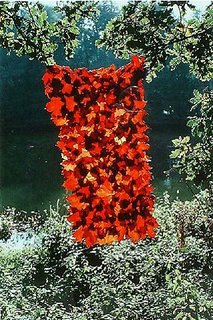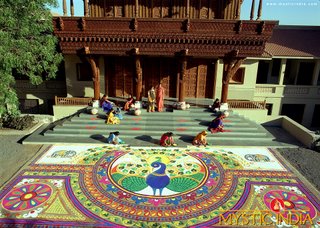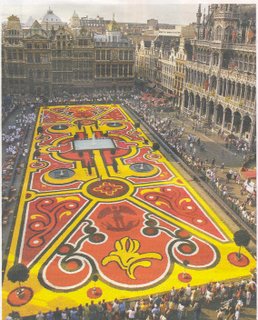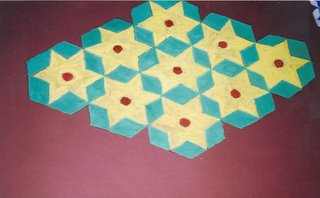TRADITIONAL ARTS
The traditional arts which are included here and the related sites are sometimes known as Ephemeral Arts- the arts which temporary or shortlived, based on specific occasion or event and transitory in nature. Website at www.ephemeralarts.com
Thursday, September 17, 2009
FOLLOW NEW DEVELOPMENTS
Teachers can:
Access new sites. Visit http://ephemeralarts-teachers.blogspot.com/ to examine a new support programme for teachers.
Join “Ephemeral Arts Innovators” a network on http://ephemeralarts.ning.com/ It can be accessed via a bloglink.
GOOD NEWS FOR TEACHERS
The new blogs also extend the scope for celebrating Ephemeral Arts to include other subject areas in the schools cirriculum.
Ephemeral Arts for Teachers is a continuation of Mirador Cuilture's support programme for teachers who are interested in integrating the use of Ephemeral Arts in the teachnign of Arts, Anthropology, Sociology and Geography.
Ephemeral Arts Teachers is designed to become a Networking Site for Teachers of Ephemeral Arts!
In addition:
Follow general debate and discussion on Culture and Arts in the United Kingdom by visiting DIVERSE VIEW at http://diverseview.wordpress.com
We look forward to hearing from you.
Saturday, July 11, 2009
Mask The Message
The first of these interfaces is MASKS. We will be developing a new festival of Masks. People use a mask to acquire a new identity or to hide one! Sometimes, the only "mask" that a person has is their face! How many times have you failed to read someone's face?
Thursday, December 20, 2007
Thank you so much!
However, I have been thinking more about you, your school, your background, your own interests than about myself and my work!
Its time to bring you on board! Hurray! Its your time-based culture that I am going to be promoting for a few weeks.
How do you, your family or your community create artistic images that are connected to important cultural events in your life? If you are a Muslim, you will be celebrating Eid! If you are a Sikh, you will be celebrating religious events very soon. If your are a Hindu, what did you do for Diwali? If you are a Christian, how will you be celebrating Christmas?
If you are a child under 16, please let your parents and your teachers know that you are posting messages to this blog.
What creative work can we share today? Please contact me!
Tuesday, August 08, 2006
Calling ephemeral arts teachers, artists, writers and researchers
I am interested in hearing from teachers, artists, writers and researchers who are interested in the ephemeral arts. Our definition of ephemeral arts is," Arts which are temporary or short-lived, based on a specific occasion or event and transitory in nature".
A Festival of Ephemeral Arts, which is held at various locations in the United Kingdom is our main public event. It has been running for over five years and now recognised as an innovative and successful community based festival. It has been run in over 50 schools, always in conjunction with the local authority and community groups in the areas where it has been held. It first projected a South Asian cultural focus but over the years, artists have been recruited from all cultural backgrounds to create and market work to combined and mainstream audiences.
Teachers and Artists are required to work on the festival as we plan our work for the next three years. A number of proposals are under development. Your area of specialisation is important but an ability to examine the linkages between ephemeral artforms is more critical! Teachers and artists should be able to produce original concepts, develop them for public presentation and be able to engage audiences. Currently, teachers, artists and practitioners are required for adding new dimensions to the programme.
Writers and researchers are required to work on publications and to contribute to this blog as approved members.
Further information on this vast range of projects in this unique area of work is also available from the festival website. It is also being updated.
New dimensions
The Ephemeral Arts Festival and its programme is being extensively revised. A number of announcements follow this posting.
Please contact, initially by email only, to introduce yourself and your work and to suggest what you do and how you may be able to influence the course of development of this highly original area of work through festivals, workshops, seminars and a proposed annual conference. You can suggest how you work as a teacher, artist, writer or researcher. An application form will be sent and interviews arranged within 4-6 weeks for immediate opportunities in the UK. All enquiries and applications will be acknowledged.
Contact: Kalwant Ajimal, Founder, A Festival of Ephemeral Arts
email: kalwant.ajimal@btinternet.com
Monday, August 07, 2006
Exploring Ephemeral Arts - the best blog on the subject?
This site has been exploring a number of areas connected with ephemeral arts. It would be useful to examine what has been achieved so far and to outline the scope for future development of the blog as a resource for students, teachers, librarians and parents.
Further work is to be presented to address the specific areas of interest that have been identified and inspired by the blog so far. A number of students, artists and teachers have responded by email or made verbal comments. These comments will be taken on board. The blog is intended for students at GCSE and 'A' Level standard, that is, for those who may be working on projects as a part of their secondary school education. More advanced students and also their teachers may also find that elements covered here will inspire them to look further at some of the themes outlined here.
The blog is also intended for the lay reader who may just want to look at artistic expression in a different way. The blog will also be of interest to younger children who can see, interpret and enjoy the pictures provided here.
So the questions we started to address are still valid-
- what are the ephemeral arts?
- How can we interpret these forms of expression?
- What are the different ways of thinking about time-based culture?
People provide artistic expression to celebrate an event. They dress and present themselves for the occasion through artistic expression. They decorate the buildings or houses where the cultural events take place. They celebrate important events in the open air. Many of the ephemeral arts are connected to important dates in the cultural, religious, political and historical calendars of communities in different parts of the world.
Predicting future activities on this site...
I have also created some routes or pathways for investigating ephemeral arts in the future:
- Entries related to "Exploring avenues for inspiration" will examine the work of artists whose work is dedicated to time-based cultural and artistic expression, or whose output is also ephemeral. A start has been made by looking at the work of Andy Goldsworthy. There is scope for looking at the work of other artists, some of whom may not be famous or even be known.
- Further work is to be presented to address the theme," Exploring Avenues for Cultural Communication" where a range of entries will be produced to reflect the diversity of this area.
- A third theme has been added. It explores ephemeral arts by linking them to geography and to various countries where these arts are most visible.
- More themes will be added later.
Exploring sources of inspiration 2- Ephemeral arts as cultural communication
Helen Coleman(1) writes," Hairstyling and hairdressing have great cultural significance in Africa. Coiffures have been regarded as diagnostic of ethnic origin, gender, phase of life cycle, as well as simply fashion; and have been related to power, age, religion, and politics. The transitory yet highly visible nature of hair ensures its suitability as a medium for personal and social expression. It is not just the domain of women; elaborate hair styling for men can be an equally important indicator of their place in society". Hairstyling for weddings must present interesting opportunities for self-expression.
The transitory nature of hair can also be explored also in relation to beards, especially where men dress for specific occasions.
In general to what extent does the use of ephemeral arts as cultural communication vary from the original definition used for this site where the transitory arts are created for a specific event or occasion? This aspect will be explored further.
Helen Coleman's comments are drawn from 'Artword', a University of East Anglia website. www.artworld.uea.ac.uk
'Sycamore Leaves Stitched together' by Andy Goldsworthy
 This is an example of work that is transient, with a defined 'life'. It was created in Yorkshire Sculpture Park on 23 October 1987. The picture is on display at the Springer & Winckler Gallery. Source http://www.artnet.com A search using any of the regular search engines is recommended.
This is an example of work that is transient, with a defined 'life'. It was created in Yorkshire Sculpture Park on 23 October 1987. The picture is on display at the Springer & Winckler Gallery. Source http://www.artnet.com A search using any of the regular search engines is recommended.I have selected this picture from many that are available because it shows how the artist has used brightly coloured leaves, stitched them together to form a hanging object and added it to the landscape. Many, if all, of Goldsworthy's works depict his additions to the natural environment. The blog will explore how various communities use such work to add to their environment. I see this as a form of celebration of nature.
Exploring Sources of Inspiration 1- Andy Goldsworthy
Andy Goldsworthy is an environmental sculptor in which his use of the natural surroundings create an art form. He explores and experiments with various natural materiel such as leaves, grasses, stones, wood, sand, clay, ice, and snow. The seasons and weather determine the materials and the subject matter of his projects. With no preconceived ideas about what he will create, Goldsworthy relies on what nature will give him. Goldsworthy "feels" the energy from nature and transcends that energy into an art form. His transient sculptures contradict the permanence of art in its historical pretense.
Because of this mortality of nature, Goldsworthy uses the photograph as a form of documentation to capture the essence of his work. "Each work grows, stays, decays- integral parts of a cycle which the photograph shows at its height, marking the moment when the work is most alive. There is an intensity about a work at its peak that I hope is expressed in the image. Process and decay are implicit."-Andy Goldsworthy.
Source: www.arthistory.sbc.edu the site of Sweet Briar College. The site shows many examples of 'process and decay' the transient nature of work which this blog also covers.
Further Examples of Ephemeral Arts
The most notable examples in this site are drawn from the Indian Subcontinent. These are mehndi, rangoli, masks, fancy festival dress, face painting and floral decorations.
Mehndi consists of decorations of hands, feet and face by using henna paste. Mehndi is used to celebrate weddings, cultural events and now, increasingly as a fashion statement. Examples of mehndi are shown in the Mehndi Gallery. Please see the website using the links given on the left.
Rangoli shown here is another example of ephemeral arts. Rangoli is the creation of images using grains, lentils, rice, leaves and seeds to celebrate various cultural events such as Diwali and the New Year. Rangolis are also created using coloured powders, petals, soils and coloured rice. The patterns are typically colourful and often geometric in design.
Masks. There is a long tradition of mask making in the Indian Sub-continent. Used ceremonially and in street performance, masks are generally made from paper pulp or tree fibre. In performances, men will often play female roles by wearing masks. Examples of masks are provided in the exhibition.
Flower decorations. A large number of ephemeral arts, such as masks and garlands use flowers due to their short-lived beauty. Certain types, such as marigold and rose, are used more commonly used since their colour or scent religious significance.
Alpana is a floor art that uses utilises a combination of coloured pastes and flower petals.
Dussehra (spelt differently by various communities) is an annual religious Festival that commemorates the victory of good over evil, the demon Ravan. Community members build work together to build the towering effigy of Ravan and act out a ceremonial battle between good and evil. The ritual climaxes with the triumphant burning of the demon against a night sky.
Face painting is perhaps the most widespread ephemeral art, being particularly popular with children around the world. However, in the Indian Sub-Continent it has a much greater spiritual significance. Various communities use face painting to express important messages relating to cultural events.
Further examples are to be added showing the ephemeral arts from countries in Africa, North and South America, Europe, the Far East, Australia and all island communities in the world.
Do you have pictures that could be published here? Please contact me by using the email address given on the left. This site follows copyright regulations before readers' pictures can be published.
Belgian Floral Carpet
Thursday, July 13, 2006
18 Floor-based art creates an illusion
17 Image from Mystic India- Another Rangoli

This picture is taken from the Mystic India site mentioned earlier. Note the detail of rangoli patterns being out together by the women. They have to work on the floor for long hours possibly to complete the work in one day. Also try to assess the size of the rangoli by comparing the pattern with the people or the building in the background. Make sure that you visit the original Mystic India site to which this picture belongs. Please see post no 15.
16 The Victory of Good over Evil
Friday, July 07, 2006
15. Mystic India- an exciting photo gallery!
The film itself could be interest to teachers, students and researchers
One of the best and largest rangoli or floor paintings that I have seen can be found at
http://www.mysticindia.com
The photo gallery is well worth a visit!


